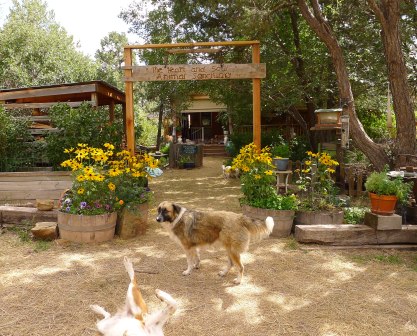
LOOK NO FURTHER than the dictionary definition: a sanctuary is “a sacred or holy place,” where revered objects are kept. The meaning also includes the idea of “refuge,” a place of protection from harm. The “animal sanctuary,” then, is a place where threatened animals can live out their lives under sacred protection.
Not surprisingly, it was a church group that created the fi rst animal sanctuary, or at least the first to popularize the name. But the founders of the Best Friends Animal Sanctuary were no ordinary church. They belonged to a “hippie church”—some called it a cult—in the 1970s. About 20 of them reunited in Arizona a decade later around a shared interest in rescuing animals. In 1983 they realized their dream of finding a huge piece of land, establishing what is now the nation’s largest no-kill animal shelter on 33,000 acres in the red-rock country near Zion National Park.
If the genesis of Best Friends is thus a little off beat, its reputation is anything but. The sanctuary gained prominence for saving thousands of pets left homeless by Hurricane Katrina and taking in most of the dogs seized from Michael Vick’s dog-fighting ring in 2006. Since the National Geographic special Dog Town was filmed there, 20,000 animal-lovers each year have made the pilgrimage to tiny Kanab, Utah, which has been elevated to a major tourist attraction. In 2009 the sanctuary was rated one of the “Top Five Free U.S. Attractions” by users of the website Tripadvisor, cementing its status as a household word.
The ranch itself is a small city, with some 1,700 animals in residence and more than 200 employees, plus thousands of volunteers each year. Smaller animal sanctuaries have sprouted in communities nationwide, many started by admirers. It’s no exaggeration to say that Michael Mountain, Gregory Castle, Faith Maloney, Ann Mejia, Francis Battista, and others not only invented the animal sanctuary, they helped shape a movement and a culture, lending a political identity to individuals who had been caring for homeless animals on their own.
The idea behind the animal sanctuary—and by extension the whole animal rescue movement— is no less revolutionary for that. It reflects a large-scale shift in our attitudes toward animals, from tools to be used to family members to be cherished. Of course, traditional cultures treated animals as sacred, too, but primarily as representatives of a group, embodiments of divine spirit. At the animal sanctuary, each individual animal is considered sacred for its unique soul. That’s why there’s such emphasis placed on death and the afterlife, with prominent gravesites, memorials, and shrines erected to individual animals in the manner of saints in a church.
New Mexico has long been a magnet for animal-lovers, just as it is for artists and spiritual seekers, so the state has many more animal sanctuaries per capita than one would expect. Many of them take in pets, but there is also a wolf sanctuary, a sheep sanctuary, a few devoted to farm animals, and a half dozen to horses, not to mention animal rescue groups for all manner of wild and domestic creature, from chickens and skunks to hamsters and ferrets.
It’s not possible to rescue every animal in need, of course, and no sanctuary tries. They exist instead to express, in commitment and devotion, the worthwhile wish that it were.
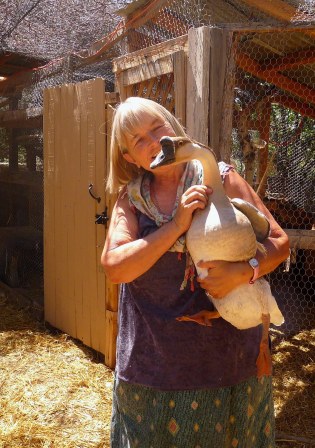
The Final Station
Kindred Spirits Animal Sanctuary
Cerrillos, N.M.
KINDRED SPIRITS Animal Sanctuary is not visible from the highway. Your arrival is announced instead by an orchestra of resident dogs—none of them jumping with excitement, however, as happy as they may be. That’s because the youngest one is 12, and the seniority just climbs from there.
Ulla Pederson, the kindly earth goddess who tends this unusual garden, shakes her head with a smile at the surprise people show at dogs who live past the age of 20. She has had any number of them at her hospice for animals— the most famous being a tiny Chihuahua who arrived at age 18, and thrived for six more years.
There is a turkey that is 21 years old. The goose that greets Pederson as she enters the first pen in a maze of bird enclosures—honking continuously for a bite from the grain bucket—is about 15. He was living in a milk crate, Pederson says, until a young person in the family sprung him out.
She founded the sanctuary officially in 2002 after years of visits to the Best Friends Animal Sanctuary in Utah. Pederson had grown up on a farm in Denmark and had a career in nursing and education. So she decided, upon retirement, to work with the animals she knew best—dogs, horses, and poultry—and especially the ones nearing the end of their lives. Currently that means about 20 dogs, three horses, and maybe 70 barnyard fowl, a number that allows comfort for all.
“I’ve always been drawn to the elderly,” Pederson explains. “It’s their quiet wisdom, the having been around.” Sensible and unsentimental about death, she has acquired from hospice work the serenity that comes from standing at the gate between worlds. “In my view, we miss them,” she says of the animals whose memorials decorate every room. “But they’re spiritual beings, and I perceive them as going home.
“I feel them as angels here, helping out,” she adds. “They haven’t gone away, but are part of it in a different way. Which is no small thing.”
Everything on the grounds of Kindred Spirits flows from Pederson’s understanding of what creatures need to be truly well, just as the pens flow from each other like rooms in an ancient pueblo. The environment is free of toxins, so even microorganisms can thrive. Beyond that, residents who come from traumatic situations benefit from security and routine, personal freedom, and a sense of belonging for the rest of their days. Never again will they have to look for home—they have found it.
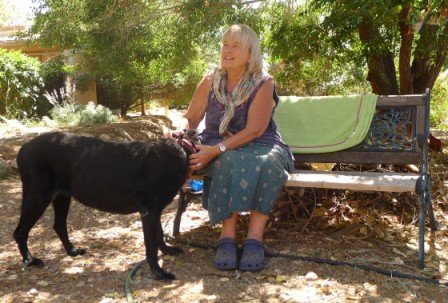
Down to every last rooster and turkey, the animals demonstrate the
blossoming born of the sort of compassionate environment that, Pederson
notes, many humans go without in our “throwaway culture.” The chickens
don’t scoot away when humans approach. The peacocks strut their pens
with a sense of ownership. One rooster even gives a visitor a flying
warning kick! The dogs do not follow the humans around, but seem content
to wander, sleep, sniff at their own pace.
“They have sanctuary—they know that,” Pederson says. “You see they have their own interests.”
Every day there is a set hour for sleeping, for eating, for play, for
wandering. Veterinarians and alternative practitioners come to offer
pain management and help with mobility, but no invasive interventions to
prevent the natural arrival of death.
Through her persistent, low-key efforts over the last 11 years,
Pederson has developed a team of volunteers, a dozen of whom regularly
care for the animals. Add to that twice-yearly open houses, a
newsletter, an annual art show, visits by school and church groups,
education events, workshops, and now internships.
Pederson ascribes the current fascination with animals to “collective
guilt,” wanting to make restitution for the harm that has been done and
“leave a place a little better than we found it.” Which is not a bad
thing, she adds.
The sanctuary’s poster child is a yellow Pit Bull named Salvador who
died in 2009. He was probably used as a bait dog, he arrived at the
sanctuary so crippled and mangled. “We carried him around on a stretcher
so he could be with us,” Pederson recalls. “He was worked on by a team
of healers.” Salvador grew such a following around Santa Fe that he was
mourned in multiple press obituaries. “He had such a big heart, people
would come just to sit with him,” Pederson says, bowing her head with
reverence. “He was such a teacher.”
The spirit of Salvador embodies the very essence of the sanctuary
philosophy— that each sentient being deserves safety, comfort, and care;
that there is value in caring for any and all beings; that each and
every one of us, while living, can help others and continue to grow.
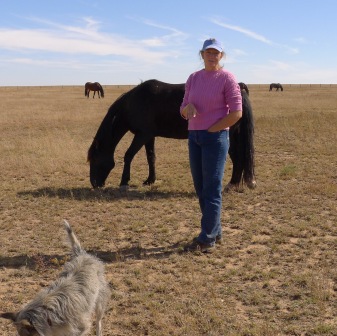
Free at Last
Cimarron Sky-Dog Sanctuary
Watrous, N.M.
HORSES AREN'T exactly pets, and don’t need us to live well. So providing sanctuary for them falls in a slightly different category than for dogs and cats—somewhere on the continuum between animal rescue and wildlife refuge.
Cimarron Sky Dog Sanctuary offers a good example of their narrow ambitions. In her unapologetically pure motivation to see horses live free, founder Jackie Fleming eschews adoption, volunteers, tour groups, educational outreach, and sometimes even fundraising. All she wants is to provide for as many horses as possible—currently 36—to live the rest of their lives relatively free of human intervention.
Freedom is, after all, what so many people see embodied in the mustangs of the West. It is what lends the animals their magnificence, and makes their roundup by federal agencies so tragic, especially when it leads to the slaughterhouse.
“I can’t even describe what it’s like to pick up horses from the BLM and turn them loose,” Fleming says in her clean British English, product of international schools in Asia. “It’s the best high. You open the trailer door, and they can do what horses were meant to do. They’re here for life.”
If you had told her as a child that she would live on 1,100 acres of open range with two dozen mustangs, she would have been unimaginably thrilled, she says—which means she counts her life a success. Growing up in Hong Kong and Singapore as the child of a boat builder, she had little experience around horses. But once they moved to England and she began to ride, the addiction was permanent.
Like many gypsy spirits, Fleming made her way to California and stayed. She was continually disappointed, however, in her quest to trail-ride, like in the Westerns—until she visited a friend in Santa Fe. Her quest over, she moved to Cerrillos in 1994 and stopped wandering.
Only gradually did her passion for horses lead to giving up everything for this, a piece of land outside Watrous, New Mexico, where two dozen horses can roam free.
“I can’t answer sensibly why I don’t adopt them out,” she says of the nonprofit she founded in 2000, which has reached its grazing capacity and will not accept more animals. “It’s hard to say no—you hear terrible stories. But every time I adopt one, I make a mental promise that the existing horses will be OK.”
Drought has forced her to feed hay at a cost of $5,000 a month. So the first goal is to keep both horses and range healthy. Beyond that, Fleming is content to live alone, painting and writing, spending time with the horses and her terrier mix, Holly, who chases butterflies.
“People say, ‘But are they wild?' I use the word free. They get to decide every day what they want to do. I don’t give them treats or tell them what to do. I don’t want to make them into useful horses.”
Indeed, some of the animals widen their distance at our approach, while others stand only close enough to stare. One young gelding who was born in a BLM holding pen nudges our hands in the hope of being petted. Some of her mustangs still cannot be touched, much less ridden. And since she has several “riding” horses at her trailer in the Mora Valley, Fleming feels that’s as it should be. “Most people don’t want horses they can’t use,” she notes.
Her wish to keep animals safe forever was born out of a traumatic experience. In Cerrillos, one of Fleming’s horses died tragically on a trail ride. Guilty as a bereaved parent, she felt the need to make something of it. “Initially it was, let me take in a horse or two that needs it.” When she started accepting mustangs, however, the number quickly rose— though every stallion is gelded.
With her youngest horse now 5, Fleming will take none younger. She hopes they will all grow old together, “I hate to say ‘forever’ and make promises, because we never know. But for as long as I can make it happen.”
The way she sees it, mustangs are torn from their families and lose their freedom forever. While she cannot give that back to them, at least “when they get here, they make friends for life. I like the idea that this would be their last herd.”
Clearly, sanctuary exists also in the hope that they will be the same for her.

Guarding
an Oasis
Olde Windmill Farm Sanctuary
Cerrillos, N.M.
SOME ALTRUISTS, driven by their beliefs, create room in their hearts and lives to provide sanctuary for others. Karin Brandi’s story is a bit different. She moved in search of solitude in the Galisteo Basin, miles from the nearest neighbor, only to discover that she had moved to a natural sanctuary for free-roaming animals. Brandi will tell you there are no accidents in life. So she accepted her assignment and became their caretaker.
To reach the Olde Windmill Farm Sanctuary is not just a matter of googling the address. You pretty much need a guide across the longest 6 miles of single-track dirt you will find in New Mexico, starting from rural Cerrillos.
Here on 42 acres abutting BLM rangeland between I-25 and the Turquoise Trail, Brandi and her ex-husband Andy began building a home in 2001. They had come from Ohio originally, but moved to Albuquerque after her parents acquired a piece of land in 1997. When her parents split up, the couple bought this remote property with a working well.
What they did not know was that their pond and stock tanks drew animals from miles around. Four horses started appearing regularly, including an old white gelding that people had seen wandering the mesa. “Snowy was out here by himself for a long time,” Brandi says of the horse, now 43. “The other three were released later. People did help them.”
Winters are hard in the high desert, with scant forage, cold and snow. Cows started showing up on the property soon after Brandi and Andy moved into their home in 2003.
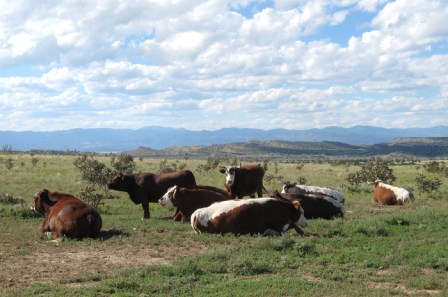
“They looked just horrible,” she said—starving and injured from
encounters with wild dogs. The couple started feeding the cows, then
paid for them when they learned they belonged to a rancher. Thanks to
bulls that range on the BLM acreage, the five cows are now 13.
This vast no-man’s-land turns out to be a dumping ground for animals in
hard times. In the fall of 2009, six more horses turned up, some
showing clear signs of neglect. Several horses were purchased out of
abuse.
The farm’s 13 cows, 17 horses, donkey, and two dogs are all precious to
Brandi and Andy, who still lives on the property with his own two dogs.
The expense of feeding and caring for so many animals led the two to
seek help and incorporate as a nonprofit a few years ago. Now they get
some assistance with building, repairs, and veterinary care. But it is
still an all-consuming life.
“It’s very stressful,” Brandi admits. “It’s a big commitment. But it’s
also the most rewarding thing. If someone had told me 13 years ago that I
would have an animal sanctuary, I would not have believed it. But it
just felt like the right thing to do.”
Given her choice of neighborhood, it’s clear that Karin Brandi is far
from conventional. A graphic designer and painter, she alludes to a
metaphysical orientation that brought her to this remote corner of New
Mexico.
“People don’t realize that animals are just like us, in different form,” she says. “The animals teach you so much.”
Life away from human society has also given her perspective on the
biological hierarchy. She recalls being lifted up and carried by a
near-stampede one day while feeding the cows alone in the round pen. “I
prayed that night, thank you,” she says of surviving the ordeal. “After
that, we started putting the hay in first. It’s a big learning curve.”
Coyotes and feral dogs stalk the property, and she strikes feeding
bargains with them. Electricity comes from the sun, heating from
propane. Food and supplies are stocked a couple times a month, though in
winter Andy must make the harrowing drive to town every other day for a
truckload of animal feed. Both of them are growing older, but Brandi
seems unworried about any future assignments.
“To me, everything is kind of planned out when you start your life,”
she says. “I just believe doors open when they have to.”
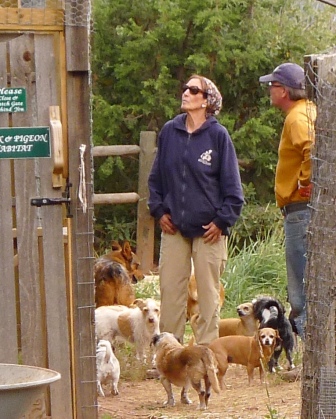
Heaven
on Earth
Heart & Soul
Animal Sanctuary
Glorieta, N.M.
THE FIRST permitted animal sanctuary in New Mexico and certainly the most written about, Heart and Soul is perhaps the clearest example of how animal sanctuaries reflect the passionate evangelism of their founders. A dog rescuer before there was a name for it, Natalie Owings ran a sanctuary before most people knew what that was. Over the last two decades she has been in the news repeatedly for the kind of animal activism that used to be considered eccentric before so many started doing it.
Access to the sanctuary begins and ends with Owings, who thankfully acquired a phone line in recent years so she can give directions. Her 130-acre property tucked in the hills of Glorieta is reached by unsigned dirt roads. Once you do arrive, however, notices everywhere indicate that you are on sacred ground—so tread carefully.
The main house is her signature installment, dubbed the Giant Dog House because it is occupied by some 30 dogs at a time that sleep around her bed. Dog cushions take up every available inch of floor space, along with large bowls of dog food, wet and dry. When Owings gets up to walk the property, the dogs follow like a flock of chicks.
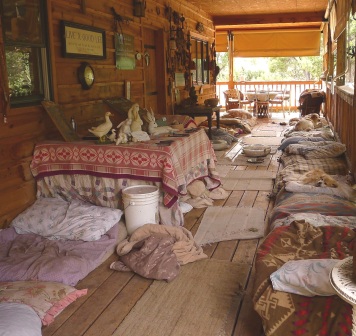
No precise census is possible, but Owings estimates that some 200
animals at a time live at the sanctuary: dogs, cats, chickens, geese,
doves, rabbits, guinea pigs, horses, donkeys, goats, and llamas, each
with its own type of enclosure.
She does not believe in caging any animal, and has parted ways with
rescue groups over the need for human socialization. What seems to
determine the parameters of each enclosure is a kind of imagined heaven.
One of the chicken pens, for example, has a tiny stream engineered
through it because chicks might drown in water dishes. “When I take in
an animal, I really get into what does that animal want,” Owings
explains. “A chicken wants a certain type of environment; a horse wants
another type of environment. I really get so into it, the staff says I
seem to be lost in my own world.”
There’s no arguing with this observation. Like other sanctuary keepers,
Owings lives according to her own clock, governed by the animals’
rhythms. She makes no appointments, she doesn’t have a computer or log
in to email.
You would never guess that Natalie Owings started her life as a
socialite, daughter of the founder of the internationally known
architecture firm Skidmore, Owings and Merrill. She married and then
divorced a grandson of Adlai Stevenson, patriarch of the Chicago
political dynasty. Back in Pojoaque, where she had been raised, she
started showing her fine art photographs in Santa Fe in the early 1990s.
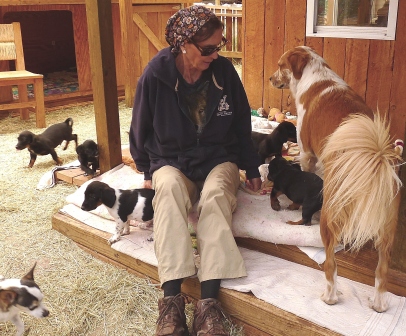
By her own account, she had been an animal-lover all her life and had
been taking in strays on her own for years. When she found herself
living with 16 dogs while trying to run an import business in Los
Alamos, “I realized it might be good to get nonprofit status.” An early
fan of Best Friends Animal Sanctuary, Owings envisioned a no-kill
facility where dogs could live out their lives free of cages. She
incorporated in 1997 on a small plot in Jacona.
Controversy erupted in 2000, leading to a rupture with her board of
directors. She was in the news again in 2011 on charges of neglect for
leaving dogs in a hot truck. This time, however, fans leaped to her
defense, reflecting the influence of thousands who had visited and
volunteered at the sanctuary over the years.
Today Owings is adamant about the urgency of moving neglected animals
out of New Mexico, which she sees saddled with “severe, Third World-like
conditions.” Whenever possible, she transports adoptable animals across
the border to Colorado.
Natalie Owings has written a 190- page book about the sanctuary, hosted
countless school groups, and served as a model to animal rescue groups
across New Mexico. But her own view of the situation here is
indisputably dark. “It’s as though they don’t see the abuse,” she says
with grief.
